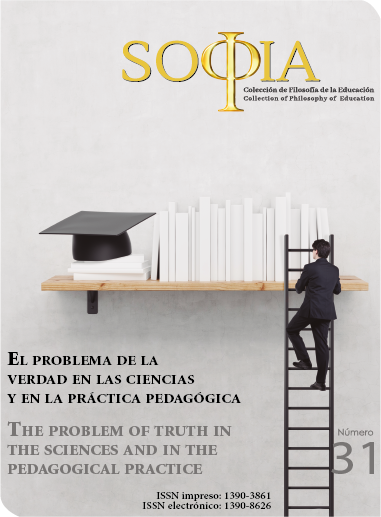Fundamentación ontológica del mundo virtual a partir de la filosofía de Nicolaï Hartmann
Contenido principal del artículo
Resumen
Detalles del artículo
Autoría: La lista de autores firmantes debe incluir únicamente a aquellas personas que hayan contribuido intelectualmente al desarrollo del trabajo. La colaboración en la recogida de datos no es, por sí misma, criterio suficiente de autoría. "Sophia" declina toda responsabilidad por posibles conflictos derivados de la autoría de los trabajos que se publiquen.
Derechos de autor: La Universidad Politécnica Salesiana preserva los derechos de autor de los artículos publicados, y favorece y permite su reutilización bajo la licencia Creative Commons Attribution-NonCommercial-ShareAlike 3.0 Ecuador. Pueden ser copiados, utilizados, difundidos, transmitidos y expuestos públicamente, siempre y cuando: i) se cite la autoría y la fuente original de su publicación (revista, editorial y URL del trabajo); ii) no se utilicen con fines comerciales; iii) se mencione la existencia y especificaciones de esta licencia.
Referencias
Barassi, V., & Treré, E. (2012). Does Web 3.0 come after Web 2.0? Deconstructing theoretical assumptions through practice. New media & society, 14(8), 1269-1285. doi: http://dx.doi.org/10.1177/1461444812445878
Barfield, W., & Danas, E. (1996). Comments on the use of olfactory displays for virtual environments. Presence: Teleoperators & Virtual Environments, 5(1), 109-121.
Bimber, O., & Raskar, R. (2005). Spatial augmented reality: Merging real and virtual worlds. AK Peters/CRC Press.
Cicovacki, P. (2001). New ways of ontology–The ways of interaction. Axiomathes, 12(3-4), 159-170. doi: https://doi.org/10.1023/A:1015852024525
Cicovacki, P. (2014). The analysis of wonder: An introduction to the philosophy of Nicolai Hartmann. New York: Bloomsbury Publishing.
Copeland, B. J. (2020). The church-turing thesis. En Stanford encyclopedia of philosophy (Summer 2020 edition). Recuperado de https://plato.stanford.edu/archives/sum2020/entries/church-turing/
Cubitt, S. (1998). Digital aesthetics. New York: Sage.
Cuéllar, H. (2013). La ontología anti-metafísica de Nicolai Hartmann. Tópicos, Revista de Filosofía, 1(1), 159–173.
De Landa, M. (1998). Meshworks, Hierarchies and Interfaces. The Virtual Dimension. J. Beckman. New Jersey: Princeton Architectural Press.
De Landa, Manuel. (2000). A thousand years of nonlinear history. New York: Swerve.
De Saussure, F., Bally, C., Sechehaye, A., Riedlinger, A., Alonso, A., & Sechehaye, A. (1980). Curso de lingüística general. Akal Madrid.
Demazeau, Y., Dignum, F., Rodríguez, J. M. C., & Bajo, J. (2010). Advances in Practical Applications of Agents and Multiagent Systems: 8th International Conference on Practical Applications of Agents and Multiagent Systems (PAAMS’10) (Vol. 70). New York: Springer Science & Business Media.
Dziadkowiec Jakub. (2011). The Layered Structure of the World in N. Hartmann’s Ontology and a Processual View. En Roberto Poli, Carlo & Scognamiglio, Frederic Tremblay. (Eds.), The Philosophy of Nicolai Hartmann (pp. 95-124). Berlín - Boston: De Gruyter.
England, P., Lampson, B., Manferdelli, J., Peinado, M., & Willman, B. (2003). A trusted open platform. IEEE Computer, 36(7), 55-62.
Espada, J. P., Martínez, O. S., Bustelo, B. C. P. G., & Lovelle, J. M. C. (2011). Virtual objects on the internet of things. IJIMAI, 1(4), 23–29.
Foster, I., Zhao, Y., Raicu, I., & Lu, S. (2008). Cloud computing and grid computing 360-degree compared. 1-10. Ieee.
Gadamer, H. G. (1991). La actualidad de lo bello: El arte como juego, símbolo y fiesta (Vol. 15; R. Argullol, Trad.). Barcelona [etc.]: Paidós.
Gadamer, H.-G. (1993). Verdad y Método I (Quinta Edición en español). Salamanca: Sigueme.
Guizzardi, Giancarlo, & Wagner, Gerd. (2010). Using the Unified Foundational Ontology (UFO) as a Foundation for General Conceptual Modeling Languages. En Theory and Applications of Ontology: Computer Applications. Dordrecht Heidelberg London New York: Springer.
Hartmann, N. (1986). Ontologia III, La fábrica del mundo real. México: Fondo de Cultura Economica.
Hartmann, N., & Peterson, K. R. (2012). How Is Critical Ontology Possible? Toward the Foundation of the General Theory of the Categories, Part One (1923). Axiomathes, 22(3), 315-354.
Henderson, K. (1999). On line and on paper: Visual representations, visual culture, and computer graphics in design engineering. Cambridge, MA: MIT Press.
Klusch, M. (2012). Intelligent information agents: Agent-based information discovery and management on the Internet. Springer Science & Business Media.
Laurel, B., & Mountford, S. J. (1990). The art of human-computer interface design. Addison-Wesley Longman Publishing Co., Inc.
Lieberman, H., Paternò, F., Klann, M., & Wulf, V. (2006). End-user development: An emerging paradigm. En End user development (Vols. 1–Book, Section, pp. 1-8). Springer.doi: http://dx.doi.org/10.1007/1-4020-5386-X_1
McCarthy, J. (1965). LISP 1.5 programmer’s manual. MIT press.
Morris, C. (1985). Fundamento de la teoría de los signos (1971). (Journal Article).
Nagel, E., & Newman, J. R. (1970). El teorema de Gódel (1ra ed.). Madrid: Tecnos.
Negroponte, N., & Plaking, D. (1995). Ser digital. Editorial Atlántida.
Poli, R., Healy, M., & Kameas, A. (2010). Theory and applications of ontology: Computer applications. Springer. doi: http://dx.doi.org/10.1007/978-90-481-8847-5
Poli, R., & Seibt, J. (2010). Theory and applications of ontology: Philosophical perspectives. Springer. doi: http://dx.doi.org/10.1007/978-90-481-8845-1
Poli, Roberto, R., & Obrst, Leo. (2010). The Interplay Between Ontology as Categorial Analysis and Ontology as Technology. En Theory and Applications of Ontology: Computer Applications (Vol. 2). Dordrecht Heidelberg London New York: Springer. doi: http://dx.doi.org/10.1007/978-90-481-8847-5_1
Richard, E., Tijou, A., Richard, P., & Ferrier, J.-L. (2006). Multi-modal virtual environments for education with haptic and olfactory feedback. Virtual Reality, 10(3-4), 207-225. doi: http://dx.doi.org/10.1007/s10055-006-0040-8
Russell, S. J., & Norvig, P. (2016). Artificial intelligence: A modern approach. Malaysia; Pearson Education Limited.
Sieg, W. (2008). Church without dogma: Axioms for computability. En New computational paradigms (pp. 139–152). Springer. doi: http://dx.doi.org/10.1007/978-0-387-68546-5_7
Von Neumann, J. (1993). First Draft of a Report on the EDVAC. IEEE Annals of the History of Computing, 15(4), 27–75. doi: http://dx.doi.org/10.1109/85.238389
Wong, B., Stoyanov, I., & Sirer, E. G. (2007). Octant: A Comprehensive Framework for the Geolocalization of Internet Hosts. 7, 23-23.
Woolley, B. (1994). El universo virtual. Acento Editorial.

